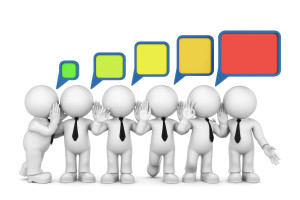You would think that as leaders grow, their people would grow. Unfortunately, the opposite is often true. Leader’s growth leads to separation and misalignment with their people which leads reduced organizational cohesion. This is especially true when leaders implement change. Many become driven to plan for change yet for every 100 hours they devote to it, only a fraction of that time for planning on how to get people “aligned” and, even less, on how to keep them aligned over time.

Chinese Whispers
From our research, flagging the challenge ahead and getting people used to a change is often done poorly or not at all. Most commonly, the effort and focus of what leaders expect falls victim to “Chinese Whispers” getting ahead of leaders change communication. Gossip and stories are passed around which with each re-telling change slightly, until what employees hear has changed beyond recognition. Consequently, those expected to implement change becomes a patchwork of the engaged, the bewildered and the belligerent.
We see this too often when leaders confuse their desired outcome; say profit, with their mission, say providing superior service. So, often in the urgency of change their “Why” gets forgotten or lost in a barrage of one-way communication. When people lose this connection with the “Why”, their “What” has little impact. In other words the lack of compelling messages means they don’t change and stick with what they have always done.
This condition manifests itself in many ways like having meetings where too many people are invited for fear they may feel left out. Agenda’s become laden with information exchange leaving no time for problem solving or decision making because there’s no shared meaning.
Many leaders pull out their hair and say things such as the following:
- Why don’t they get it!
- How many times do we have to tell them that!
They are exhibiting the familiar signs of misalignment with their people. These data give an insight why they could be misinterpreted and mistrusted. Here’s a snapshot from our research in my book “Focusing Change To Win”:
- Leaders are not focused on coaching, metrics, leadership, communication process, or rewards/recognition (8.3% of 684 comments)
- Over half of the communication methods used are one-way (289 out of 510 comments)
- Leader’s intent does not seem to focus on the culture, roles, or governance. In fact, out of 755 comments, only 14 were about roles and responsibilities
Our analysis shows that the more change leadership stays in the hands of the Few, the more the Many will feel stressed, resistant, or, at best, confused.
For many, this data is like an iceberg. The rational side of change is the 10% that leaders present and tend to focus on – Above The Waterline.
Meanwhile, Below The Waterline (90%), many are trying to relate the rationale for change with their own values, beliefs, needs, and past change experience. Such leadership communication patterns are not conducive to getting below the waterline and helping people reconcile organizational change with personal change. The result is often unnecessary stress, resistance, and confusion.
That leads us to advocate what our contributors are saying in laying the groundwork for successful change. The first criterion is developing a shared governing set of values and then getting people ready for the inevitable change ahead.
-
Agreeing What Do We Stand For? What are our Change Communication Values
For many, people values are at the core of effective communication. Essentially, treat people as you want to be treated.
Here’s what people said in the survey about genuine involvement:
- Transparency is key; otherwise, people will have reason to doubt and mistrust the initiative and therefore find ways and means to deliberately undermine the process.
- Taking care of the human element and their attendant emotions.
- Effective change needs:
- Trust
- A compelling logic
- A close match of leaders’ actions and words
- A commitment of those who are affected
- Respect for people (even departing)
- Build a culture in which change is for the larger benefit of the organization and not for an individual getting affected positively or negatively.
-
Getting People Ready for Change
Here’s a sampling of how some leaders get their people change-ready:
- Train in market and socioeconomic factors, then get [your people] involved in generating ideas to improve the situation.
- Ensure all people understand the organization’s core values, purpose, and vision to guide us. Clarify strategic objectives and engage people in problem-solving.
- Demonstrate how they build on the results they like and reverse-engineer the results they don’t.
- Banish blame from the culture through leveraging high levels of transparent communication.
- Listen to their ideas and seriously consider them.
- Regularly meet to discuss vision and strategy, so people are familiar with the organization’s room for maneuvering.
- Build esprit de corps by helping people to feel part of the whole process, and give recognition that change is largely in their hands.
- Ensure they know their part in planning the next change.
Develop common spiritual and philosophical concepts underpinning the change cross-functionally to develop the engagement process that will be responsible for changing the work culture for good.
The next stage in getting ready for change is selecting and developing specific change roles.
-
 Developing Change Agents
Developing Change Agents
While a few contributors cite using a proprietary change management model—like, Prosci, Adkar, and Kotter—a few cite introducing external change agents. Far more make reference to selecting internal change agents and engaging stakeholders to lead the charge. Additionally a few advocate setting up a central organizational development and design group.
- We first advise staff of the changes that we [are] thinking of making and what, if any, input they would like to share that we might have missed or overlooked. Progress begins the idea of change for them, so when it happens, it’s not a surprise but already a realization in their minds.
-
Involving Stakeholders Early
Some of the earliest activity for these contributors is the involvement of stakeholders and change agents. This starts with stakeholder analysis:
- Assign ownership to each process, then document and communicate the changes to the stakeholders.
- Identify and engage change agents up and down the chain to communicate and mentor people.
- Establish the change organization, and communicate who is responsible for each activity.
- Ensure that roles and responsibilities are rational.
- Identify change agents and conduct pre- and post-meeting and interacting with stakeholders.
- Introduce directly applicable tools, methods, and ideas.
- The organization publishes policy and establishes governance for the elements of the change. These measures establish responsibility for the change but fall short of creating a sense of ownership.
For more advice on effectively communicating change, go to Focusing Change To Win – A Leadership Change Manual

